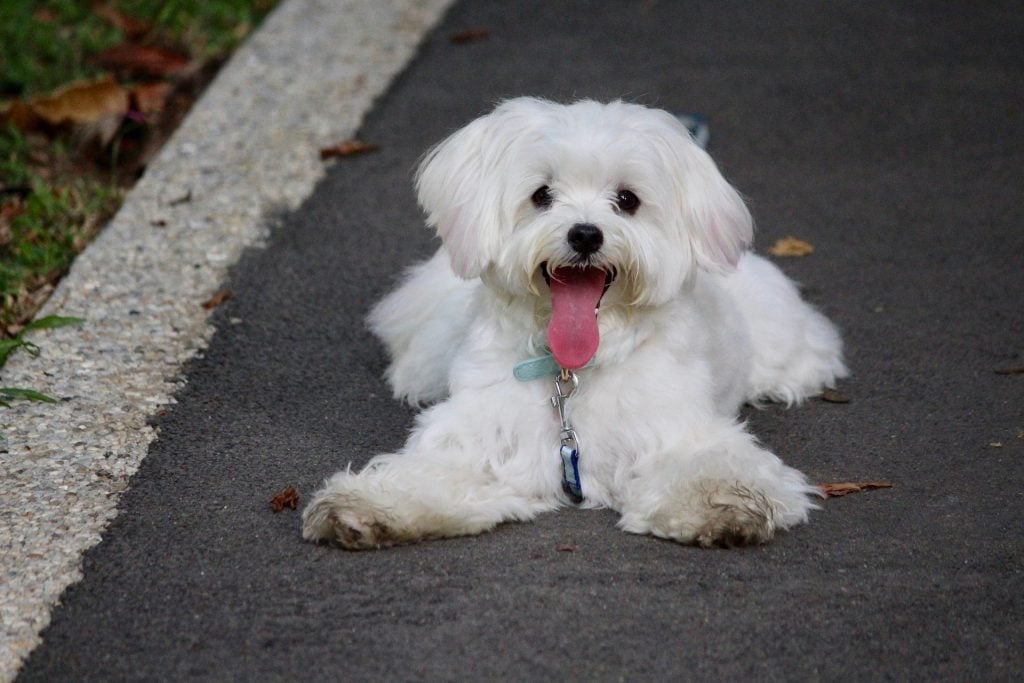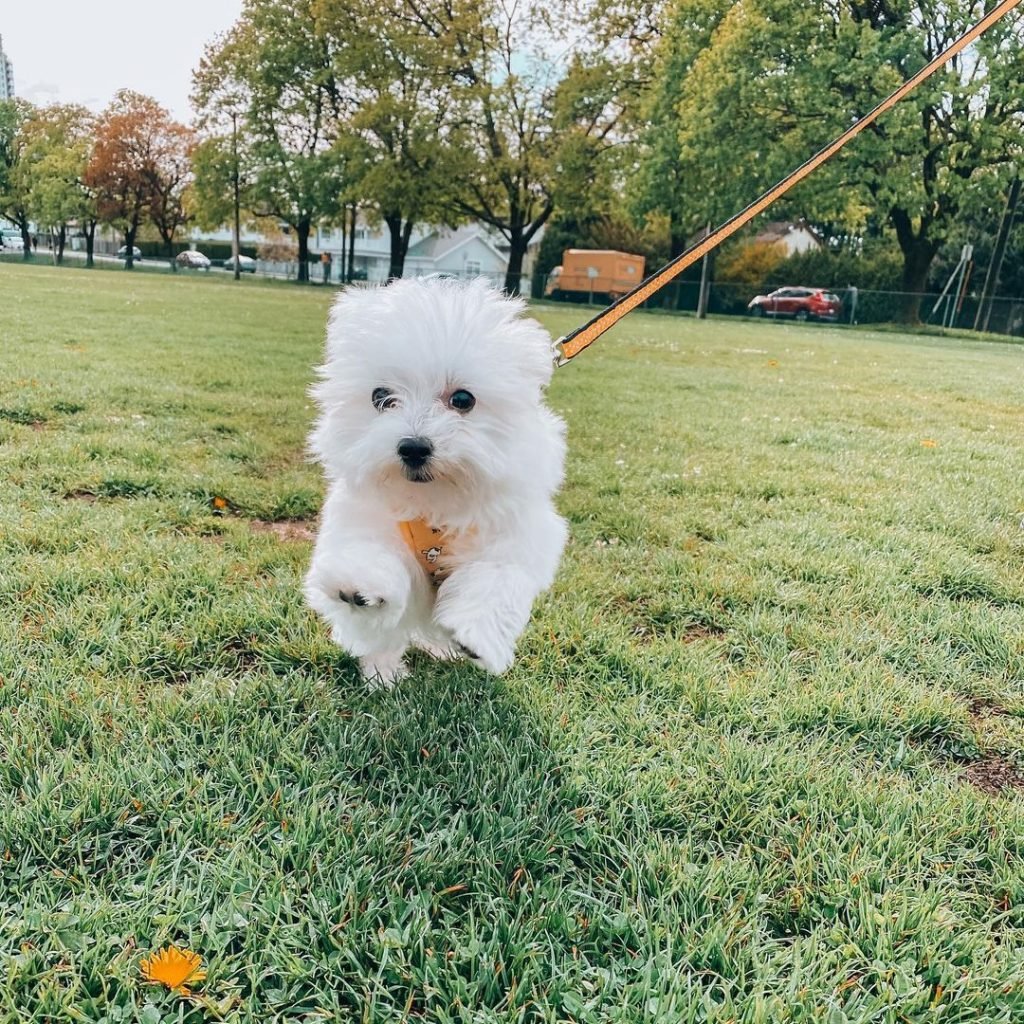
You might know Maltese dogs for their long, silky coats or tiny 3 kg stature. Don’t let that fool you—this dog breed makes both a great watchdog and couch companion. The Maltese is highly intelligent and, with training, capable of excelling in agility courses or advanced tricks. While often stubborn, they respond well to reward-based training. Their highly adaptable personality makes a great companion for all ages of pet parents and is one of the many reasons why Maltese are among the most popular dogs in the UK.
Pet owners often describe their Maltese as brave, playful, gentle and lively.
Table of Contents
- Characteristics
- Appearance
- Personality
- Ideal Environment
- Ideal Human
- Training
- Grooming
- Health
- History
- Getting a Maltese
- More on Malteses
Breed Characteristics
Key
- Low
- Medium
- High
- Origin: Mediterranean
- Size:
- Weight: Under 3.2 kg
- Activity level:
- Barking/howling level:
- Good with dogs: yes
- Good with kids: yes
- Good with cats:
- Shedding:
- Shedding: Seasonal
- Grooming level:
- Training level:
Maltese Appearance
The Maltese is in the toy breed category and weigh around 3 kg or less, with 2-2.5 kg often being ideal. Their most traditional look is one with a flowing, pure-white coat, however, more pet owners have started cutting it short for easier ongoing upkeep. The longer cut may even fall down the sides of their body, reaching the floor. Pet owners who prefer this look will often tie the hair around their face in a top knot—bow included.
Formal breed standards suggest that the coat should be sleek in texture: any curliness or kinks are objectionable. At Rover, we think regardless of the texture or haircut, they’re undeniably cute. Plus, long or short, they shed relatively little.
Both the eyes and nose of a Maltese are dark, even black in colour. Their head is a rounder shape than many other breeds with a medium-length muzzle. The Maltese has low-set ears, feathered with hair.

Maltese Personality
The Maltese is a popular dog breed for good reason. They’re smart, playful and sweet. Though their demeanour is relatively mild, pet owners can rely on their innate watchdog mentality. Similarly, Maltese dogs are one of the most loyal toy breeds—attaching themselves to their owner both on the couch and the street. Because they love lots of affection, Maltese can suffer from separation anxiety.
Maltese are unafraid. They’ll stroll up to new dogs and people comfortably. For pet owners looking for a social pup—a Maltese is a great option. Like any breed, the Maltese benefits from plenty of socialisation early on in their life. Expose them to new people, pets, smells and sights as soon as you’re comfortable.
Ideal Environment for a Maltese
The Maltese makes a great dog in both apartments and houses. While energetic, they’re petite enough to still run circles around a small space.
Because they’re alert and protective by nature, they can be vocal. If you live in an apartment that’s near a noisy stairwell, for example, you will likely need to spend extra time training a Maltese to not react. This instinct to protect the house comes from their undeniable loyalty to their owner, which is one of the things that makes them so loveable as a breed.
With proper gear and care, the Maltese can adapt to any climate and geography—urban or rural. They might need a sweater in colder climates or need to stay inside more in the winter, however.
Ideal Human for a Maltese
Don’t let that teeny body fool you: the Maltese will accompany their owner on longer walks and eagerly excel at agility courses. They’re great companions for families, as well as seniors looking for a snuggle buddy.
The Maltese requires quite a bit of affection and often don’t take well to being home alone for long periods. Pet owners who work from home or are retired would make for a great match for this breed.
For anyone hoping to welcome a Maltese into their home, their long life expectancy of 12-15 years should be considered.
It’s not surprising that the Maltese is so popular—they’ll naturally fit into most families, big or small.

Maltese Training
Outgoing by nature, Maltese are quick to join the party. This means they’ll likely be comfortable with most dogs and people. Early socialisation will ensure a smoother transition into new situations with both pets and people.
They’re extremely intelligent, which means they will pick up cues and tricks quickly. However, they also know how to get what they want from their humans and require ongoing training to keep them in check. The Maltese often responds best to reward-based training, which can be in the form of treats or overt positive reinforcement. They can err on the stubborn side, so that’s where the rewards come in handy.
Because they can suffer from separation anxiety, it’s helpful to work toward alleviating that on an ongoing basis. Crate training can be helpful—establish a positive relationship between them and their crate early on. Then, leave them in their crate for short periods of time, slowly ramping up to longer periods. Don’t use the crate as a form of punishment and only reward them when they go into their crate, not when they get out. To help alleviate separation anxiety, experts often recommend use of puzzle toys to keep them engaged.
Maltese Grooming
The Maltese is known for a long, glorious coat, but many pet owners instead opt for a shorter cut. It’s up to the individual pet parent to decide what’s best for them—both are cute, but the longer style requires daily maintenance.
It’s important to brush a Maltese with a longer coat daily to prevent mats and tangles. A frequent bath with coat conditioning helps it stay soft and shiny.
For a Maltese with a shorter cut, weekly brushing should be sufficient to stimulate the skin to produce healthy natural oils.
Regardless, Maltese dogs have fast-growing nails, requiring you—or a groomer—to clip them often. Every time you brush their coat, make sure to also brush their teeth, as this breed is more susceptible to dental disease in old age.
Maltese Health
Like any other breed, the Maltese should be fed according to their age and size. A higher-quality food with less byproducts is beneficial and can be achieved at different price points—some more accessible than others.
Because they respond so well to reward-based training, they’re often given too many treats, leading to obesity. Obesity in dogs will lead to other health problems and ultimately reduce their life expectancy.
Learn about which human foods are safe for dogs and which are not.
While Maltese is a relatively healthy breed of dog, the Kennel Club recommends (if you’re not adopting) that you work with a responsible breeder that screens for inbreeding, which amplifies health risks. The British Veterinary Association also notes that the Maltese is susceptible to a neurological condition known as Chiari malformation Syringomyelia, which can be screened for. Luxating patellas and heart disease are other potential health issues.
Like all breeds in the toy group, the Maltese benefits from a daily teeth regimen. Using dog-safe toothpaste is a plus! Many pet parents opt for pet health insurance, just in case.
Maltese History
It’s tricky to pinpoint the exact origin of the Maltese breed because it’s so ancient. They’ve trotted around the Mediterranean for thousands of years. Many believe the breed was brought to the island of Malta, off the coast of Italy, during its colonisation by the Phoenicians.
The little, white dogs were treasured, mostly by women, for their proportional faces and elegant coats. Having a Maltese on your lap became synonymous with wealth, serving as a status symbol above all else.
This narrative continued with women in the Roman Empire ‘wearing’ their Maltese as an accessory, perhaps peeping out of their sleeve.
People in China eventually took to the breed, keeping the long lineage alive. The breed later became a staple at dog shows and was part of New York’s first Westminster show in the late 19th century. The Maltese dog also has a long history with royalty in the UK, with Mary Queen of Scots among their regal fans.
Getting a Maltese
Like we mentioned above, the Maltese makes a great pet for a wide range of pet parents. If you’re hoping to adopt a dog, there are often Maltese of varying ages waiting in rescues for their forever home. While we often expect rescues to have mostly mixed-breed dogs, many report that a majority of their rescue dogs come from individual owners who surrender the dog due to a change in lifestyle or the breed not being right for them.
However, if you’re looking for a puppy, it might be tougher to find one. The benefit of adopting a dog is that they may already be house-trained and have been microchipped and spayed/neutered.
If you’re hoping to get a Maltese from a breeder, it’s important to do the research to find an ethical breeder that you can trust. Thankfully, there are many resources out there to help inform this research and decision, as well as avoid puppy farms or unethical breeders. A good place to start is also the Kennel Club’s assured breeders scheme.
Regardless, get ready for an energetic bundle of joy in your home.
More on Malteses
Manic about the Maltese? Can’t wait to make a Maltese your very own companion? We’ve got more for you: